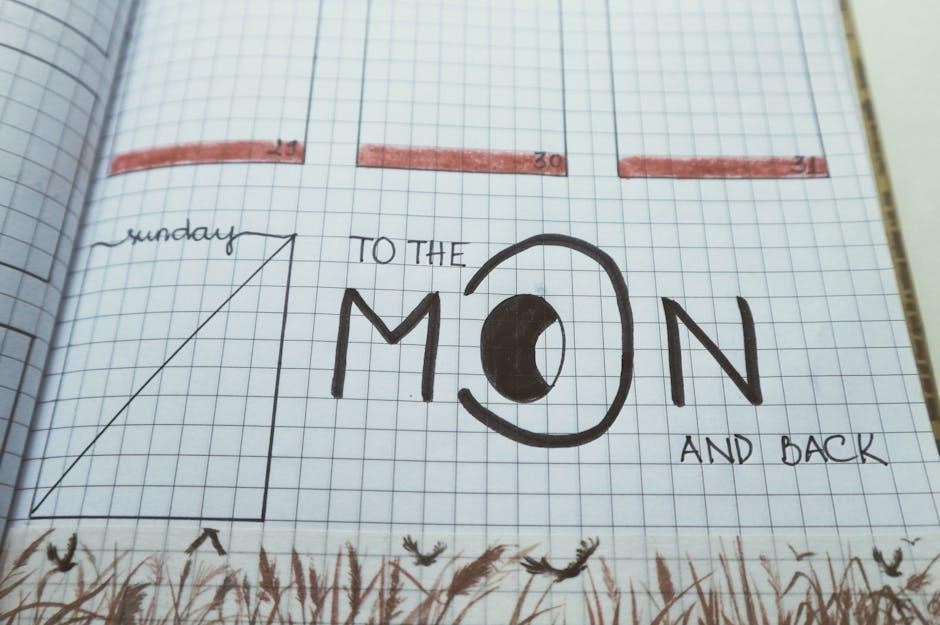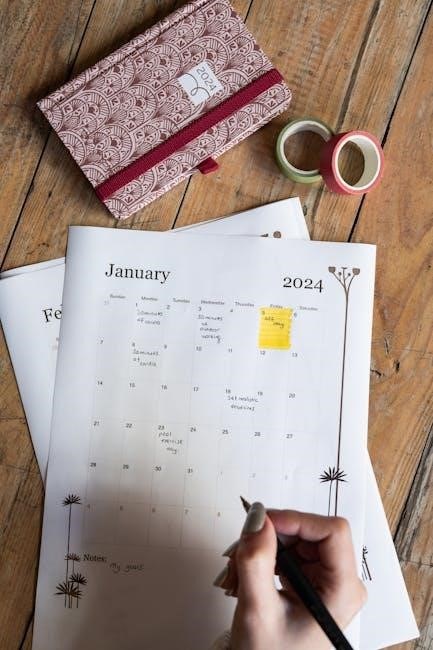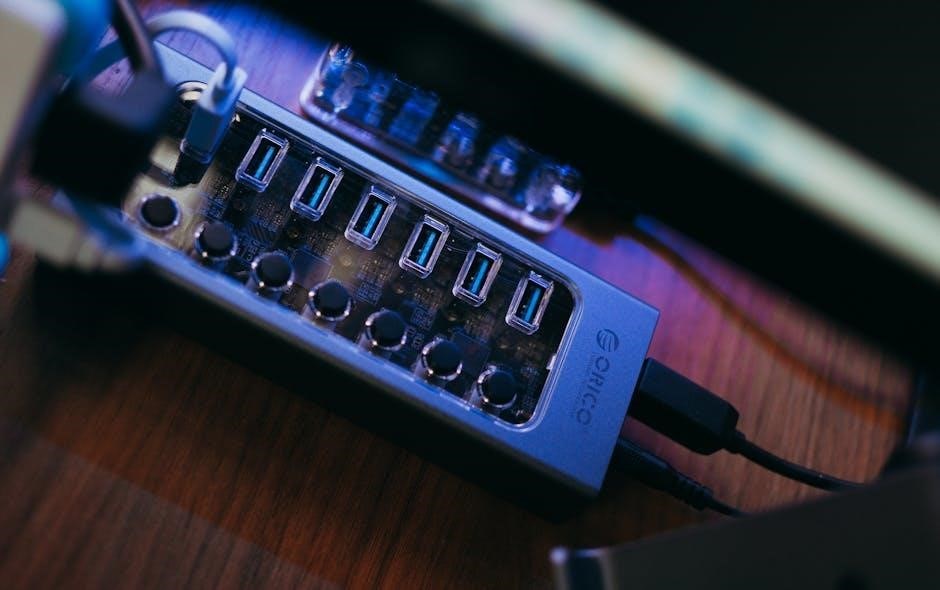crochet magic ring pdf
The magic ring is a fundamental technique in crochet‚ ideal for creating neat‚ invisible joins when working in the round. Surprisingly easy for all skill levels‚ it revolutionizes projects like amigurumi and hats‚ offering versatility and a professional finish. Discover how this technique transforms your crochet experience with step-by-step guides and expert tips.
1.1 What is a Magic Ring in Crochet?
The magic ring‚ also known as a magic loop‚ is a versatile crochet technique used to create a nearly invisible join when starting a project worked in the round. It eliminates the need for a traditional starting chain‚ allowing for a neat and secure foundation. This method is particularly popular for amigurumi toys‚ hats‚ and granny squares‚ as it provides a professional finish. Surprisingly easy to master‚ the magic ring is a game-changer for crocheters of all skill levels‚ offering precision and flexibility. Whether you’re a beginner or an experienced crafter‚ this technique ensures a clean‚ polished start to your projects‚ making it an essential skill in your crochet toolkit.
1.2 Importance of the Magic Ring in Crochet Projects
The magic ring is a cornerstone technique in crochet‚ offering a clean and professional start to projects worked in the round. Its importance lies in its ability to eliminate bulky starting chains and create an invisible join‚ resulting in a polished finish. This method is particularly valuable for amigurumi toys‚ granny squares‚ and hats‚ where a seamless base is essential. It saves time and effort‚ allowing crocheters to focus on intricate stitch patterns without compromising the project’s aesthetics. The magic ring is also ideal for beginners‚ as it simplifies the process of starting a project‚ making it an indispensable skill for crocheters of all skill levels.

Benefits of Using the Magic Ring
The magic ring is a game-changer for crocheters‚ eliminating bulky starting chains and creating seamless‚ invisible joins. It enhances project appearance‚ simplifies working in the round‚ and suits all skill levels‚ making crochet more efficient and enjoyable.
2.1 Eliminates the Need for a Starting Chain
The magic ring technique removes the need for a traditional starting chain‚ creating a seamless and invisible join. This method is particularly useful for projects worked in the round‚ such as hats‚ amigurumi toys‚ and granny squares. By eliminating the starting chain‚ the magic ring provides a clean and professional finish‚ making it ideal for patterns requiring a circular base. It also saves time and avoids the bulkiness often associated with chain stitches. The magic ring is a game-changer for crocheters‚ offering a sleek and modern way to begin projects while maintaining even tension and a polished appearance from the very start.
2.2 Creates a Neat and Invisible Join
The magic ring is renowned for producing a neat and invisible join‚ making it a favorite among crocheters. Unlike traditional methods that leave a visible seam‚ the magic ring ensures a seamless transition between stitches. This feature is especially advantageous for projects like hats‚ scarves‚ and amigurumi toys‚ where a clean finish is desired. The invisible join not only enhances the aesthetic appeal of the work but also provides a professional touch. By eliminating bulky seams‚ the magic ring technique allows for a smooth‚ even surface that is both durable and visually appealing. This characteristic makes it a must-learn skill for crocheters aiming to create high-quality‚ polished projects.
2.3 Ideal for Projects Worked in the Round
The magic ring is particularly well-suited for projects worked in the round‚ such as hats‚ beanies‚ and amigurumi toys. Its ability to create a seamless starting point allows for smooth‚ even stitching without the bulk of a traditional starting chain. This makes it ideal for projects that require a circular foundation. The magic ring ensures that the first round of stitches lies flat and even‚ providing a solid base for the rest of the project. Whether you’re making a cozy beanie or a cute stuffed animal‚ the magic ring offers the perfect start‚ resulting in a professional and polished finish. This technique is a game-changer for anyone working on circular crochet projects.

Materials Needed for the Magic Ring
A crochet hook‚ yarn‚ tapestry needle‚ scissors‚ and stitch markers are essential. Choose the right hook size and yarn weight for your project to ensure even tension and a professional finish.
3.1 Crochet Hook Sizes and Types
Choosing the right crochet hook is crucial for achieving the perfect tension in your magic ring project. Hook sizes vary‚ and selecting the correct one ensures your stitches are neither too tight nor too loose. Aluminum‚ steel‚ or ergonomic hooks are popular choices‚ with each offering unique benefits. Aluminum hooks are lightweight and durable‚ while steel hooks provide excellent stitch control. Ergonomic hooks are designed for comfort during long crochet sessions. Always refer to the yarn label for recommended hook sizes to ensure compatibility. The right hook size and type will make creating a magic ring effortless and enjoyable‚ whether you’re a beginner or an experienced crocheter.
3.2 Yarn Choices for Magic Ring Projects
Choosing the right yarn is essential for successful magic ring projects. Selecting a yarn that complements your project’s purpose ensures the best results. Acrylic‚ cotton‚ and blends are popular choices due to their durability and softness. Acrylic yarns are versatile and work well for amigurumi toys‚ while cotton is ideal for items like dishcloths or market bags. Consider the weight of the yarn‚ as lighter weights create delicate fabric‚ whereas heavier weights offer structure. Always check the yarn label for recommended hook sizes to ensure compatibility. The color and texture of the yarn will also impact the final look of your project. Experiment with different yarn types to find the perfect match for your magic ring creations.
3.3 Additional Tools (Tapestry Needle‚ Scissors‚ etc.)
Beyond the crochet hook and yarn‚ several additional tools are essential for magic ring projects. A tapestry needle is indispensable for weaving in ends neatly‚ ensuring a professional finish. Scissors are necessary for cutting the yarn as needed. Stitch markers can help track the beginning of rounds or specific stitches‚ especially in complex patterns. A measuring tape or ruler is useful for checking the size of your work. Optional tools include a yarn needle for sewing seams and a small stitch dictionary for reference. These tools collectively enhance your crocheting experience‚ making it easier to manage your project and achieve the desired results. Always keep them handy to streamline your workflow.
Step-by-Step Guide to Creating a Magic Ring
Learn to create a magic ring with ease. This quick technique is perfect for beginners and advanced crocheters alike‚ offering a seamless start for projects worked in the round.
4.1 How to Pull Up the Initial Loops
To begin‚ hold the yarn in your non-dominant hand‚ create a small loop‚ and insert the crochet hook through the center. Gently pull up the initial loops‚ ensuring they are evenly spaced. This step is crucial for maintaining the integrity of the magic ring. Adjust the loop size as needed to achieve the desired tension. Once the loops are in place‚ secure the ring by crocheting into the first stitch. This technique ensures a seamless and invisible join‚ perfect for projects like amigurumi toys or hats. Keep the loops tight enough to prevent gaps but not so tight that the fabric becomes rigid. Practice makes perfect in mastering this foundational step.
4.2 Adjusting the Ring for Even Tension

After pulling up the initial loops‚ adjust the magic ring to ensure even tension. Gently pull the yarn to tighten or loosen the loops as needed. Too tight‚ and the ring may pucker; too loose‚ and it may gap. Use your fingers or the crochet hook to tweak the loops‚ ensuring they lie flat and evenly spaced. Proper tension is key to a professional finish. To maintain consistency‚ work in a smooth‚ steady motion‚ avoiding abrupt pulls. If the ring feels misshapen‚ carefully adjust the loops before securing them. Even tension ensures your project starts neatly and sets the stage for flawless stitching. Practice adjusting the ring to achieve the perfect balance for your crochet work.

4.3 Securing the Ring to Start Crocheting
To secure the magic ring‚ insert your crochet hook into the ring and pull up a loop of yarn. Then‚ create a slip stitch to tighten the ring‚ ensuring it is snug but not overly tight. Gently pull the yarn tail to close the ring evenly. Make sure the stitches are evenly spaced and the ring lies flat. If the ring feels too tight or too loose‚ adjust it before proceeding. Once secured‚ count your stitches to ensure accuracy. Properly securing the ring is essential for a smooth start to your crochet project. This step ensures a clean foundation‚ making it easier to work seamlessly in the round. A well-secured ring prevents gaps and ensures even tension for professional-looking results.

Common Mistakes When Using the Magic Ring
Common mistakes include making the ring too loose‚ leading to a sloppy join‚ or pulling it too tight‚ causing puckering. Both can disrupt the project’s appearance.
5.1 Making the Ring Too Loose
Making the magic ring too loose is a common mistake that can lead to a sloppy join or a visible hole in the center of your project. This often happens when too much yarn is used to create the initial loop‚ or when the tension is not adjusted properly. A loose ring can be particularly problematic for projects like amigurumi toys‚ where a tight‚ clean circle is essential for the desired shape. To avoid this‚ ensure the yarn is pulled snugly but not overly tight‚ and adjust the ring’s size before securing it. Using the correct hook size and yarn weight also helps maintain proper tension. If the ring feels too loose‚ gently pull the yarn tail to tighten it before starting your stitches.
5.2 Pulling the Ring Too Tight
Pulling the magic ring too tight is another common mistake that can lead to a misshapen or puckered fabric; When the ring is overly tightened‚ it can cause the stitches to become uneven or even impossible to crochet into‚ especially in projects worked in the round. This issue often arises when the crocheter over-tightens the yarn tail to secure the ring. To avoid this‚ ensure the ring is snug but still allows for easy stitching. If the ring feels too tight‚ gently loosen it by tugging on the yarn tail before starting your first round. Proper tension is key to achieving a smooth‚ professional finish in your crochet projects.
Advanced Techniques with the Magic Ring
Pulling the ring too tight can cause puckering or uneven stitches. Ensure it’s snug but not overly tight for smooth‚ professional results.

6.1 Working with Multiple Colors
When working with multiple colors using the magic ring‚ you can achieve vibrant‚ intricate designs. To switch colors‚ simply fasten off the current yarn and pull up the new color through the magic ring. This method allows for seamless color transitions without visible joins. For multi-color projects‚ carry the yarn behind your work and crochet over it to hide the strands. This technique is especially useful for amigurumi toys‚ granny squares‚ and other colorful patterns. Ensure to keep tension consistent when switching colors to maintain the shape of your project. Planning your color sequence in advance will help you achieve professional-looking results.
6.2 Incorporating Different Stitch Patterns
Incorporating various stitch patterns into your magic ring projects enhances creativity and texture. Common stitches like single crochet‚ half double crochet‚ and double crochet can be seamlessly integrated. For intricate designs‚ try adding shell stitches or V-stitches directly into the ring. The magic ring’s flexibility allows for smooth transitions between patterns. When combining stitches‚ ensure tension remains consistent to maintain the project’s shape. Experimenting with stitch variations can create unique fabrics‚ from dense and firm to loose and airy. This technique is ideal for creating complex designs‚ such as flowers or mandalas‚ without sacrificing the ring’s invisibility. Proper planning ensures a cohesive and visually appealing finished product.
Popular Projects That Use the Magic Ring
Popular projects include amigurumi toys‚ granny squares‚ crochet hats‚ and coasters. These projects thrive with the magic ring‚ offering a neat‚ invisible join and professional finish.
7;1 Amigurumi Toys
Amigurumi toys are one of the most popular projects that use the magic ring. These adorable stuffed animals or characters require a tight‚ invisible circle to start‚ making the magic ring the perfect technique. It eliminates bulk from the starting chain‚ allowing for a clean‚ professional finish. The magic ring is especially ideal for amigurumi because it creates a secure foundation for stuffing. Many crocheters use this method for toys like cute animals‚ dolls‚ and cartoon characters. The technique ensures that the bottom of the toy is seamless and sturdy‚ preventing gaps or looseness. It’s a must-try for anyone crafting amigurumi‚ offering both simplicity and precision.
7.2 Crochet Hats and Beanies
Crochet hats and beanies greatly benefit from the magic ring technique‚ which provides a seamless and invisible join at the crown. This method eliminates the need for a starting chain‚ reducing bulk and creating a polished appearance. The magic ring is especially advantageous for hats worked in the round‚ as it ensures a smooth‚ even start without visible seams. It allows for precise control over the initial stitches‚ making it easier to achieve the desired fit and avoid puckering. Whether crafting a simple beanie or a complex design‚ the magic ring enhances both the comfort and aesthetics of the finished product‚ making it a preferred choice for crocheters of all skill levels.

Tips for Working with the Magic Ring
Use consistent tension to maintain the ring’s shape‚ gently pull yarn to tighten‚ and ensure stitches are evenly spaced for a professional finish.
8.1 Keeping the Ring Invisible
To keep the magic ring invisible‚ ensure even tension while crocheting. Avoid pulling the yarn too tightly‚ as this can cause the ring to pucker or become visible. Use a tapestry needle to weave in ends neatly‚ preventing them from showing through the fabric. When working in rounds‚ maintain consistent stitch tension to avoid gaps or distortion. For amigurumi projects‚ stuff the item firmly before closing the ring to hide it completely. Practice on scrap yarn to refine your technique‚ ensuring the ring blends seamlessly into the fabric. Properly securing the ring with a slip stitch or invisible join will also help maintain its subtlety in the finished project.
8.2 Avoiding Gaps in the Stitch Pattern
Avoiding gaps in the stitch pattern when using the magic ring requires careful attention to tension and stitch placement. Ensure the initial loop is not too loose‚ as this can create visible spaces. Count your stitches regularly to maintain accuracy and prevent misalignment. Using the correct hook size for your yarn weight helps keep stitches even and tight. When closing the ring‚ pull the yarn gently but firmly to avoid leaving a hole. For projects like amigurumi‚ stuffing the piece before sealing the ring can help fill any small gaps. Practice consistent stitching to achieve a seamless and professional finish in your crochet projects.
Resources for Learning the Magic Ring
Discover free crochet magic ring PDF guides‚ video tutorials‚ and online classes to master the technique. These resources provide step-by-step instructions and visual demonstrations for all skill levels.
9.1 Free PDF Guides and Tutorials
Free crochet magic ring PDF guides are widely available online‚ offering detailed instructions for mastering the technique. These guides often include step-by-step photos‚ diagrams‚ and written instructions. Popular crochet websites like Moogly‚ The Crochet Crowd‚ and Crochet Geek provide downloadable PDFs. Many patterns for amigurumi toys‚ granny squares‚ and hats include magic ring tutorials. These resources are perfect for beginners‚ as they break down the process into manageable steps. Some PDFs also include tips for troubleshooting common mistakes. Simply search for “crochet magic ring PDF” on your favorite crochet site or platform like Etsy or Ravelry to find these helpful guides.

9.2 Video Demonstrations and Classes
Video demonstrations and online classes are excellent resources for mastering the crochet magic ring technique. Platforms like YouTube‚ Craftsy‚ and Creativebug offer tutorials led by experienced instructors. These videos provide clear‚ step-by-step guidance‚ making it easier to understand the process visually. Many classes include close-up shots and slow-motion sequences to help learners grasp intricate details. Additionally‚ some crochet communities on Facebook and Instagram share live sessions or recorded demos. These resources are particularly helpful for visual learners‚ as they allow you to pause‚ rewind‚ and practice alongside the instructor. Video tutorials often cover troubleshooting tips and variations‚ ensuring a comprehensive learning experience.

Troubleshooting Common Issues
Identify and resolve issues like uneven tension‚ misshapen rings‚ or loose joins. Adjust stitches‚ tighten‚ or redo loops for a polished finish. Practice ensures perfection.
10.1 Fixing a Misshapen Ring
If your magic ring becomes misshapen‚ gently tug the yarn to loosen it. Adjust the loops to ensure even tension and reshape the ring carefully. If it remains uneven‚ pull out the stitches and restart‚ focusing on consistent tightening. Use a tapestry needle to weave in ends neatly. Practice makes perfect‚ so don’t be discouraged. A misshapen ring can lead to gaps or a distorted base‚ so fixing it early is crucial. Keep the ring small and tight‚ but not overly so‚ to maintain a clean‚ professional finish. Proper adjustment ensures a sturdy foundation for your crochet project‚ avoiding future complications.
Mastery of the magic ring technique enhances crochet projects‚ offering a clean‚ professional finish. It’s a versatile and essential skill for crafters‚ ensuring seamless and polished results.
11.1 Final Thoughts on Mastering the Magic Ring
Mastery of the magic ring technique is a cornerstone of crochet‚ offering a clean and professional finish to projects. It’s a versatile method that enhances both functionality and aesthetics‚ making it indispensable for crafters. By eliminating the need for a starting chain and creating an invisible join‚ the magic ring elevates the quality of amigurumi toys‚ hats‚ and other circular projects. With practice‚ crocheters can achieve consistent tension and avoid common mistakes. Troubleshooting tips and resources‚ such as detailed PDF guides and video tutorials‚ are invaluable for refining this skill. Embrace the magic ring to unlock creative freedom and produce polished‚ professional results in every stitch.











































































